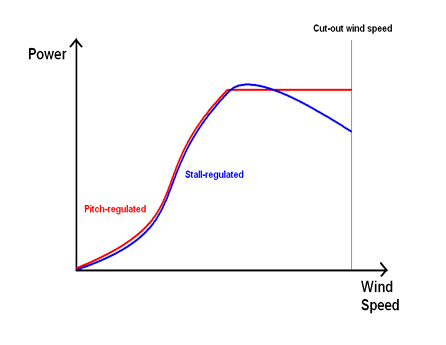Pitch-regulated and Stall-regulated Wind Turbine
Introduction
Turbines are designed to withstand extreme winds statically. This means that they can survive a storm, but only when they are not spinning. They are not designed for extreme rotational torques or speeds. At very large aerodynamic torques or rotational speeds, the forces on the blades and other parts of the turbine are enormous and it will literally tear the turbine apart. This is why they are always designed with a cut-out speed above which breaks will slow the turbine to a halt. However, there is s range of wind speeds before the cut-out speed where turbines employ various active and passive control strategies to deal with high wind speeds that would otherwise pose a threat to the turbines. These control strategies can broadly be classified as pitch-regulated and stall-regulated, respectively.
Pitch-regulated wind turbine have an active control system that can vary the pitch angle (turn the blade around its own axis) of the turbine blades to decrease the torque produced by the blades in a fixed-speed turbine and to decrease the rotational speed in variable-speed turbines. This type of control is usually employed for high wind speeds only (usually above the rated speed), when high rotational speeds and aerodynamic torques can damage the equipment. When wind speeds get very high (above rated power), the blades will pitch so that there is less lift and more drag due to increasing flow separation along the blade length (the blades are pitched into stall). This will slow down the turbine’s rotational speed or the torque transferred to the shaft so that the rotational speed or the torque is kept constant below a set threshold. Pitch regulated turbines see increasing power up until the rated wind speed, beyond which it sees constant power up until a cut–out speed when the pitch control is no longer able to limit the rotational speed/aerodynamic torque or where other forces like structural vibrations, turbulence or gusts pose a threat to a rotating turbine. In the graphic below, the pitch-regulated turbine is represented by the red curve:

Stall-regulated wind turbine, on the other hand, have their blades designed so that when wind speeds are high, the rotational speed or the aerodynamic torque, and thus the power production, decreases with increasing wind speed above a certain value (usually not the same as the rated wind speed). This behavior is illustrate above, where a typical stall-regulated turbine is represented by the blue curve. The decrease in power with increasing wind speeds is due to aerodynamic effects on the turbine blades (regions of the blade are stalled, propagating from the hub and outwards with increasing wind speeds). The blades are designed so that they will perform worse (in terms of energy extraction) in high wind speeds to protect the wind turbine without the need for active controls. The benefit of stall-regulation over pitch-regulation is limited the capital cost of the turbine, as well as lower maintenance associated with more moving parts. Like the pitch-regulated wind turbine, stall-regulated wind turbine also have brakes to bring the turbine to a halt in extreme wind speeds.
The difference then, between pitch-regulated and stall-regulated wind turbine, is mostly noticeable in high wind speeds. While the stall-regulated systems rely on the aerodynamic design of the blades to control the aerodynamic torque or the rotational speed of the turbine in high wind speeds, the pitch-regulated systems use an active pitch control for the blades. This allows the pitch-regulated systems to have a constant power output above the rated wind speed, while the stall-regulated systems are not able to keep a constant power output in high winds.
References & Resources
- N/A
Latest Post
- Dependency injection
- Directives and Pipes
- Data binding
- HTTP Get vs. Post
- Node.js is everywhere
- MongoDB root user
- Combine JavaScript and CSS
- Inline Small JavaScript and CSS
- Minify JavaScript and CSS
- Defer Parsing of JavaScript
- Prefer Async Script Loading
- Components, Bootstrap and DOM
- What is HEAD in git?
- Show the changes in Git.
- What is AngularJS 2?
- Confidence Interval for a Population Mean
- Accuracy vs. Precision
- Sampling Distribution
- Working with the Normal Distribution
- Standardized score - Z score
- Percentile
- Evaluating the Normal Distribution
- What is Nodejs? Advantages and disadvantage?
- How do I debug Nodejs applications?
- Sync directory search using fs.readdirSync